Building an email list is and powerful way to connect with your audience and boost your brand engagement. It gives you a dedicated channel for nurturing leads and keeping customers informed about new offerings and updates associated with your business.
There are various ways you can build an email list– some of them include running ads, using social media posts, or lead magnets. Our focus today is on building an email list on a WordPress website.
Keep reading as we unpack this guide to building and growing your email list on a WordPress site.
What Is an Email List?
An email list is essentially a collection of email addresses gathered from individuals who have willingly opted to receive email newsletters, updates, or promotional content from you. A well-curated email list serves as a powerful asset for your business. For one it allows you to deliver targeted email marketing campaigns with exclusive content. Utilizing WordPress email marketing plugins can significantly enhance these campaigns by automating the process, offering customizable templates, and providing insightful analytics to optimize your strategy.
The strategic nature of an email list enables you to build lasting relationships with your subscribers by consistently delivering value.
Additionally, the email list acts as a valuable tool for driving conversions, whether it’s for product sales on your online store, event registrations, or other desired actions.
8 ways to build an email list on WordPress site
Let’s now dive into a practical guide for building your email list on WordPress site.
1. In the Sidebar, add a Form
Adding an effective email signup form to your WordPress site’s sidebar is a practical and user-friendly way to curate a list of subscribers.
The sidebar is a great place for a subscription form because it’s always there – users see it as they read your content or navigate your site. Typically, your sidebar doesn’t interrupt their experience but rather complements it, giving visitors a seamless chance to subscribe without taking them away from the main content.
When designing the email subscription form, ask for essential information like their name and email address. Long forms can be a turn-off, so keeping it short makes it easy for visitors to quickly sign up. Here’s a good example on OptinMonster’s site:
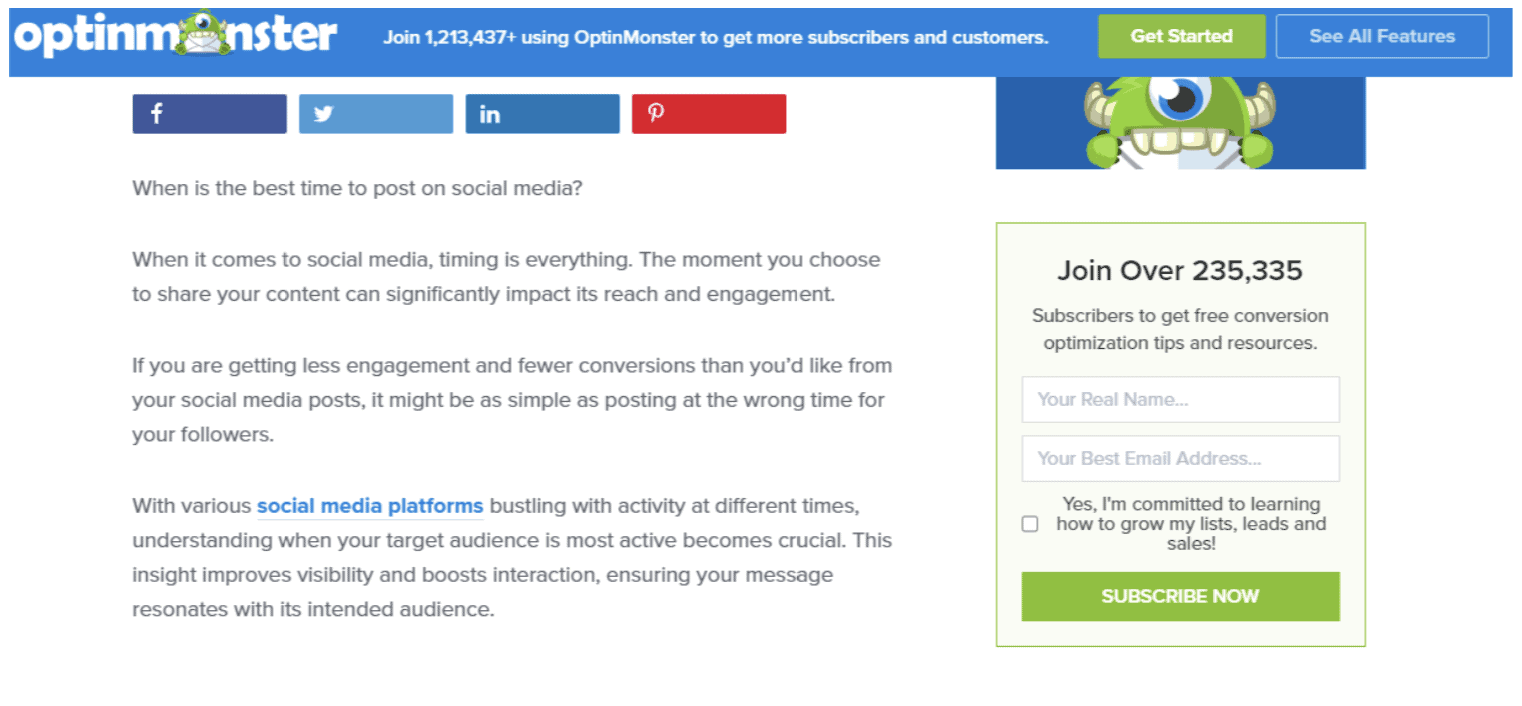
Also, consider adding a clear message next to the form, explaining why someone should subscribe. For OptinMonster, they didn’t hesitate to make good use of social proof, stating that they already have a lot of subscribers.

Also, see how OptinMonster spells out what their newsletters offer next to the checkbox above.
Stating your promise like this allows users to understand the value they’ll get from joining your email list.
2. Include a Sign-Up Form After Posts
Strategically placing a sign-up form at the end of your blog posts is a powerful tactic for gathering an email list on a WordPress site.
After reading an entire blog content, visitors have invested time and interest in your content. So, placing a signup form at this point capitalizes on their engagement. This helps you to present a clear call to action when their interest is at its peak. It’s a natural next step for those who have found value in your content and wish to stay updated. See how Fanbooster creatively adds a simple sign-up form at the end of its blog post:
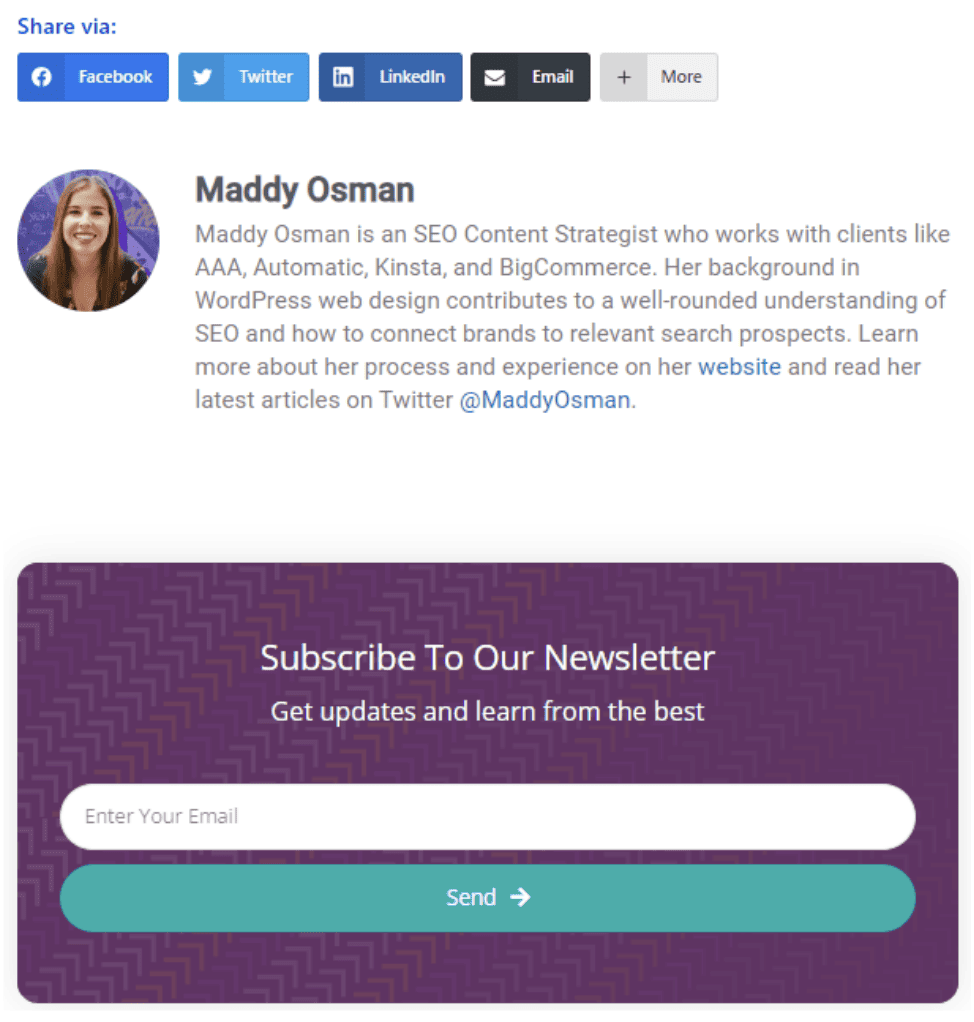
Like the form on your sidebar, the opt-in form after your blog post should also be simple and easy to fill out.
As you publish blog posts on your website, don’t forget to share on social platforms too. Your Facebook, X, or Instagram followers, are potential email subscribers that may be interested in your blog post.
3. Create a Dedicated Landing Page
Create a dedicated landing page for promoting your email list. The primary focus of this page should be to communicate the clear benefits of subscribing. It’ll also help to ease the subscription process for your users. Especially when you intend to segment your email list. For example, TedBlog has a dedicated landing page that shows different email lists that visitors can sign up for:

When using landing pages, it can be more effective to add a lead magnet— something that entices users to subscribe. These lead magnets could be free downloadable content, promotions, or regular updates. In the example below, RentRedi offers a free report:
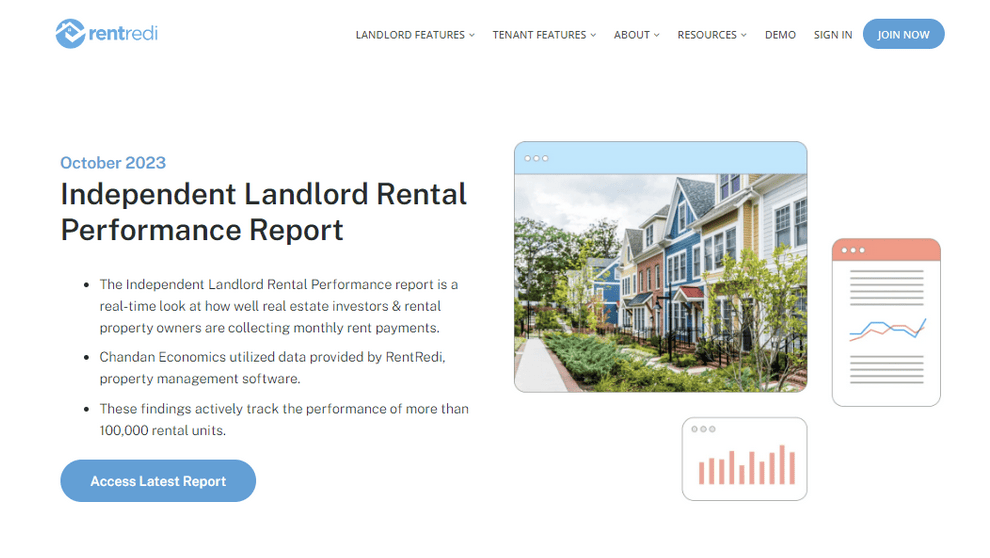
Don’t forget to optimize your landing page. Use a reliable web hosting provider to ensure that your site’s speed is efficient, as a slow page can lead to user frustration and abandonment. Also, use compelling visuals that align with your brand and the message you’re conveying. Break up content into digestible sections, incorporating headers and bullet points for easy reading.
Finally, be sure to make the subscription process straightforward as this is crucial for better conversion. Additionally, consider using a clear and prominent call-to-action button that allows users to complete the subscription.
4. Have a Slide-in or Popup Form on Your Site
Pop-ups are quite dynamic and can be triggered in various ways. For instance, being on your web page for a specific time duration, or scrolling to a particular section on your web page. As users interact with your content, a well-timed popup or slide-in can draw their focus to your email subscription offer. This way, you can capture attention and prompt immediate sign-ups.
When it comes to timing, if your popup appears too quickly it may come off as intrusive, potentially leading to a negative user experience. On the flip side, if it appears too late, users might miss it entirely if they don’t stay too long on your page. So, striking the right balance ensures that the form captures attention without disrupting the natural flow of your user’s interaction. An aversion of 5-6 seconds should be fine.
To encourage sign-ups, the content of the popup or slide-in form should be compelling and concise. Use visually appealing design elements to make the offer stand out. And don’t forget to tell users the value they’ll get from your emails. See an example on Kartell’s pop-up form:
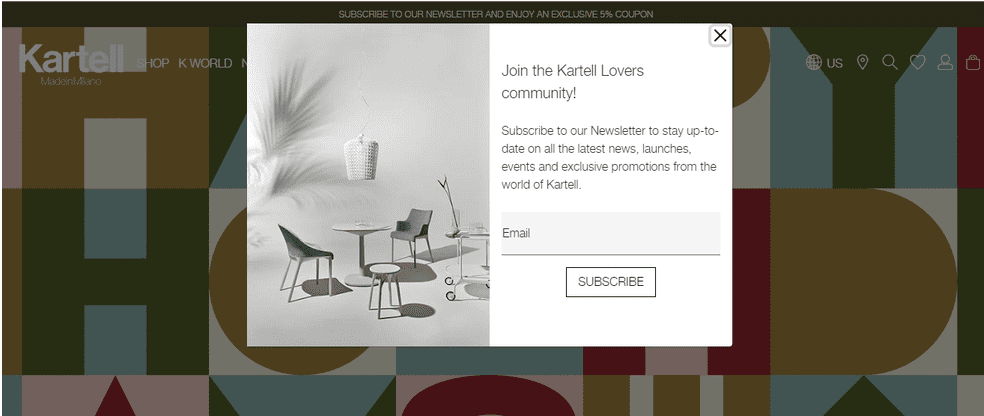
It’s essential to provide an identifiable way for users to close the popup if they choose not to subscribe. User-friendly design, coupled with an easily accessible close button, respects the user’s decisions and prevents frustration.
Slide-ins can also be used to promote a lead magnet. For example, Zoomshift’s blog on Excel work schedule features a slide-in at the bottom of the page. When users click the “Tell Me More” button they’re prompted to provide an email to access the free content.

Consider A/B testing different variations of your popup or slide-in to understand what resonates best with your audience. Also, analyze user behavior and conversion rates so you can fine-tune the timing, content, and design for the best results.
5. Using GetResponse
Using email marketing services like GetResponse can significantly streamline and enhance your efforts in building and managing an email list. With GetResponse seamlessly integrated into your WordPress site, you can access various features designed to optimize your email marketing strategy.
One notable feature of GetResponse is its user-friendly forms and popups. These forms can be easily tailored to match your website’s aesthetic, ensuring a cohesive and professional look. Also, the simplicity of the form creation process allows you to quickly generate eye-catching subscription forms without the need for extensive design skills.

Some examples of the signup form templates you’ll find in GetResponse
Additionally, GetResponse provides you with automation workflows that you can use to set up a series of actions based on specific user behavior. For instance, you can automate welcome emails with a confirmation message for new subscribers. You can also set up drip email marketing campaigns to nurture leads over time or re-engage emails for inactive subscribers. This not only saves time but ensures timely and consistent communication with your audience.

GetResponse also offers advanced segmentation options, enabling you to categorize your subscribers based on various criteria such as behavior, location, or preferences. With this, you have all you need to create highly targeted and personalized email campaigns, increasing the relevance of your content to specific audience segments.
6. Have a Joint Venture
Collaborating with others who share a similar target audience is one way you can expand your reach, and significantly increase the pool of potential subscribers.
Align with partners who complement rather than compete with your offerings. This may sometimes mean having your content featured on other niche-related websites and featuring other creators on your site.
By cross-promoting each other’s content or products, you tap into a new audience that may have a genuine interest in what you provide. This helps you to establish credibility as recommendations from trusted sources would typically carry weight with their audience. For instance, Matt Diggity of Diggity Marketing collaborates with Accredible on a blog post and earns a backlink to his website.
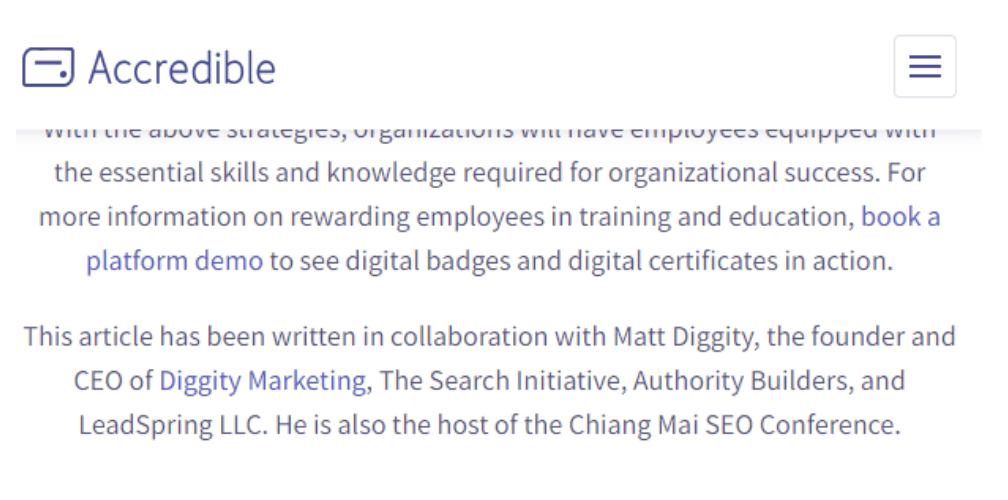
To make your joint ventures effective, be sure to communicate the terms of collaboration. Also, ensure a fair exchange of promotional efforts. This could involve featuring each other in newsletters, co-hosting webinars, or even creating joint content pieces.
Keep in mind that you also need collaborators whose audience you would naturally fit into and vice versa. This way, it’s easier to engage and resonate with potential subscribers.
7. Land a Guest Post to Drive Traffic to a Landing Page
To drive targeted traffic to your WordPress site and boost your email list, start by crafting guest posts for reputable websites within your industry. Choose platforms with an audience that aligns with your target demographic to ensure relevance.
To discover valuable guest post opportunities, begin by researching reputable websites within your industry that accept guest contributions. A simple Google search with the phrase “write for us + your niche” or “Guest post + your niche” can be helpful here.
For example, if you’re an insurance expert, you can run a search using the keyword “Guest post + insurance”, this can help you discover authoritative sites that are willing to accept guest posts in exchange for a link.

You can also explore industry-related blogs, online publications, or niche communities that frequently feature guest contributions.
Once you find an ideal opportunity, feel free to send your pitch or article based on the host sites’ guidelines. An important tip here is to pitch topics that are trendy or valuable to the site’s audience. For instance, if you’re contributing to an insurance site, topics like ‘Generative AI for insurance’ or ‘How AI is helping insurance brokers’ could resonate well with the site’s readers.
When writing your guest post, focus on providing valuable content that positions you as an authority and encourages readers to explore more. Include a strategically placed link in your guest post, directing readers to a dedicated landing page on your WordPress site. This landing page should seamlessly extend the narrative or offer additional valuable content related to your guest post. The page should also prompt visitors to subscribe to your email list.
When the guest post is live, you may also collaborate with the host site to promote it through social platforms, newsletters, or other channels. This way, you may be able to amplify the post reach and attract more traffic to your landing page.
8. Use Jetpack for Follower Subscriptions
Jetpack is a comprehensive WordPress plugin that offers a suite of features to enhance the functionality and performance of your WordPress site.
As seen below, JetPack can help you set up an effective way to turn visitors into subscribers:
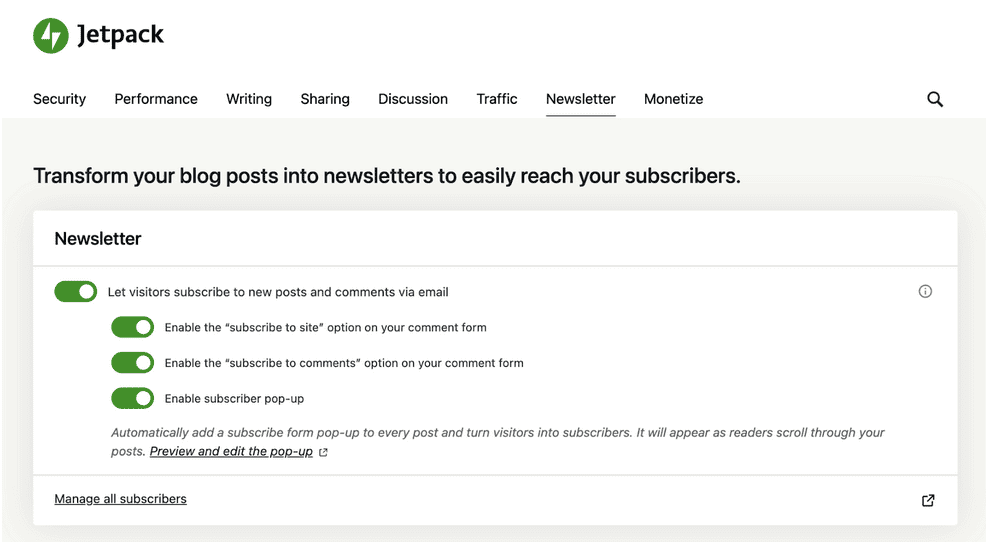
To effortlessly manage and expand your WordPress site’s email list, install and activate Jetpack if you don’t already have it.
Once Jetpack is completely set up, enable the follower subscriptions feature in your site’s settings and customize subscription options based on your audience’s preferences. Once this is done, you’ll have a simple subscription button that visitors can easily interact with. Typically, it’ll look like what we have in the example below:
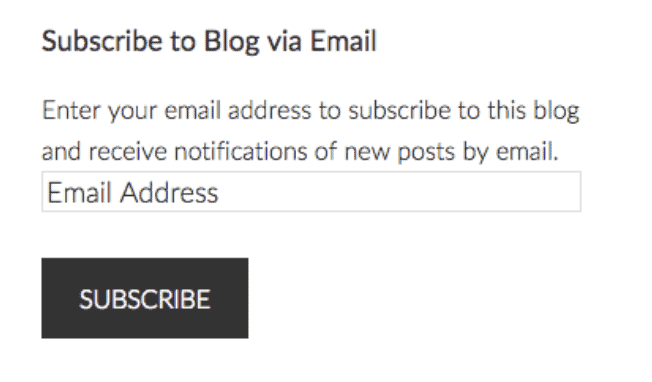
Users who subscribe will receive updates when you publish new posts or other visitors leave comments on your content.
You can monitor your subscriber count and analytics conveniently through Jetpack’s dashboard. So, it’s easy to track engagement and optimize your content strategy. Stay updated on Jetpack features by regularly checking for updates, ensuring you make the most of this plugin’s capabilities.
Conclusion
Building an email list on your WordPress site is a strategic way to connect and engage with your target audience through personalized and well-thought-out content.
We explored some vital tips for creating your email list through a WordPress site. Start by strategically placing a subscription form in the sidebar, taking advantage of its visibility and accessibility. Place a sign-up form at the end of your posts to capture the attention of readers who have found value in your content. Also, designing a dedicated landing page focused on clear benefits streamlines the subscription process for better conversion.
That’s not all, consider using slide-in or popup forms to engage your audience as they navigate your site. Leverage tools like GetResponse to streamline your efforts with features like customizable forms, advanced segmentation, and email automation. Collaborate with others in your niche through joint ventures to expand your reach and increase potential subscribers.
Drive targeted traffic by writing guest posts for industry-related websites, and then linking back to a dedicated landing page. Finally, simplify the process with Jetpack, to enable follower subscriptions and provide your audience with an easy way to stay connected.
Now it’s over to you. Go on to implement these tips we’ve provided on your website as you build your email list. Good luck
Author bio:
Meet Michal Leszczynski, Head of Content Marketing and Partnerships at GetResponse. With 10+ years of experience, Michal is a seasoned expert in all things online marketing. He’s a prolific writer, skilled webinar host, and engaging public speaker. Outside of business hours, Michal shares his wealth of knowledge as an Email Marketing lecturer at Kozminski University in Warsaw. You can reach out and connect with Michal on LinkedIn.
